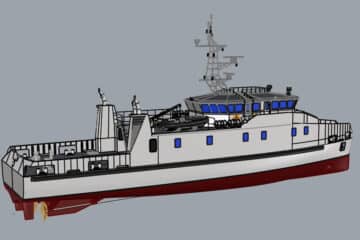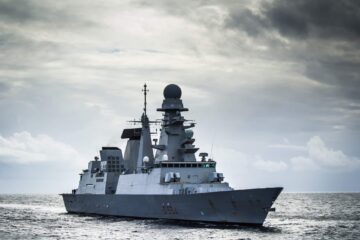The accelerated tender for a total value of €7.4 million “was launched for the temporary unavailability of fixed installations for the storage and distribution of air-naval fuels in the naval bases of the Italian Navy,” the tender documentation explains. This “is leading to various critical issues of capacitive nature in the specific sector, in particular in the bases of La Spezia and Brindisi.”
The strategy developed to compensate for this capacity gap, according to NAVARM, “involves the procurement of a tanker available on the market capable of providing the necessary services, subject to an initial chartering period of one year aimed at ensuring in the shortest possible timeline the storage and distribution of naval fuel, and the necessary training activity for the operational, technical and logistical management of the platform by Italian Navy personnel,” once the ship will be transferred to the service after the year-long charter.
The parties interested in the tender have to make questions and respond to them by 11 March 2024. The tender is divided into two phases: Phase 1 regards the exclusive year-long (365 days) chartering service with a civilian crew of the selected oil tanker, which remains in the ownership of the provider. The contract operations should start by the beginning of July 2024. Once the year-long chartering service is completed, the provider has to conduct all the necessary maintenance and dock activities and obtain the confirmation/renewal of the Condition Assessment Programme level 1 (CAP1) certificate by the ship classification society in 60 days. Once obtaining it, the ownership transfer will be completed in 30 days with the delivery of the naval platform at La Spezia Naval Base. The contract covers a warranty period for the maintenance activities of one year after delivery.
According to the tender documentation, the offered naval platform should be registered under the Italian or one European Union (EU) member state’s Fleet Register and the owner/management company should have a registered office in Italy or an EU member state. During the charter period, as part of the offered service, the ship should be manned by a civilian crew with proven experience in bunkering activities in Italian ports, and the personnel should have an EU passport and speak fluently Italian, while the provider will have to respect all the EU labor and safety regulations.
The naval platform should have the C-OIL Tanker class notation by a ship classification society belonging to the International Association of Classification Societies (IACS) and to be inspected to be certified according to the latest Oil Companies International Marine Forum (OCIMF) Harmonized Vessel Particulars Questionnaire. It should feature an overall max length of 80 meters, a max beam, and draught of respectively 15 and 6 meters, a propulsion system based on two diesel engines on two shaft lines capable of ensuring a speed at full load of circa 10 knots with Sea State 3. The platform should have an autonomy of 3 days and fuel to ensure at least 2,000 nm endurance. It should have a 4-to-6-meter tender RHIB.
The crude oil tanker, which should have been built in the last 20 years, should comply with the prescriptions of the RINA classification (or equivalent) rules in terms of ship stability, maneuverability, and sea keeping, but not have a combat system as it should not be part of naval groups and won’t be deployed in scenarios characterized by threats.
The ship should have bow and stern mooring areas and be capable of being moored with ships on each side. The platform should have one or plus bow thrusters and a propulsion control station on the bridge wings. It should have accommodations and services for at least 10 persons (of which at least two are dedicated to Italian Navy personnel) with a medical first aid premise, galley, and mess.
It should have a cargo capacity of not less than 2,300 m³ of F76 naval gasoil divided in at least 8 storage tanks (in addition to the fuel for the ship operations), with two primary and secondary pumps and fuel embarkation/delivery stations amidships and all the equipment for intra-storage tanks fuel transfer and measurement. With the fuel provided by the Italian Navy, the ship will receive and deliver it at naval platforms, barges, and vehicle tankers of the Italian Navy. These services should be provided with a minimum notice of 6 hours, mainly at the La Spezia naval base (with sailing up to the nearby coastal depot) without excluding the possibility to provide the same services in the Brindisi naval base. The tender also indicates the potential services request in other national ports after consultation with the service provider.
The chartering service is based on an average of 10 refueling operations (min 3, max 30) of 10 to 2,000 m³ each per month and respectively 1,300 m³ (min 100 and max 3,600 m³) and 15,000 m³ of fuel transferred monthly and yearly. The harbor piloting, tugs, mooring services, and taxes are paid or provided by the Italian Navy at naval bases and national ports.
The new platform should further comply with a series of international conventions in terms of safety, environmental respect, crew security, and welfare including the EU regulation n. 471/2002 regarding the double hull adoption or the equivalent technology for the single hull crude oil tanker as modified by the EU regulation n. 1726/2003, SOLAS 1974 as subsequently amended, LOAD LINE 1966 and TONNAGE 1969 as amended, MARPOL 1973/1978 and follow-on amendments, COLREG 72, maritime labor convention certificate 2006, CO2 emission monitoring, communication and verification, renewable fuels and low emissions in addition to insurance regulations.
During the chartering period, the Italian Navy will train its personnel on board the ship to be ready to delivery in the contract’s Phase 2. After the above-mentioned 60-day maintenance and docking activities, the ship should be transferred to the Italian Navy for her manning and operations.
For the record, the Japanese Ministry of Defense (MoD) ordered two 4,900 tons Yard Oiler Tankers (YOT) in May 2020 for similar roles.






